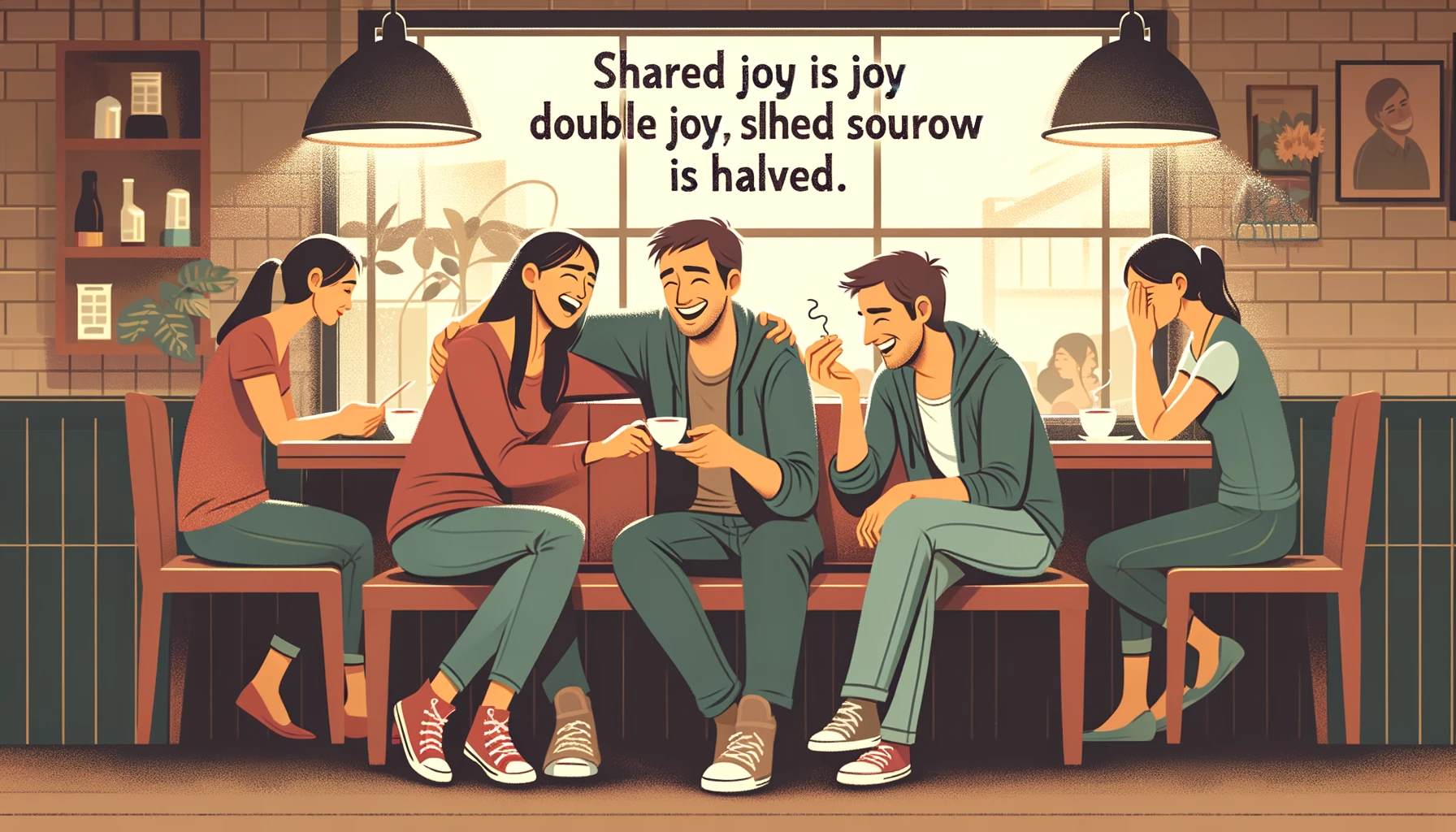Understanding the Concept of Shared Joy and Shared Sorrow
The phrase “shared joy is a double joy; shared sorrow is tymoff” encapsulates the essence of human emotional experiences and the profound impact of communal connections. At its core, this concept highlights the idea that joy experienced in isolation holds less satisfaction compared to when it is shared with others. Psychological research supports this notion, suggesting that individuals who celebrate their successes with friends and family report higher levels of happiness. By sharing delightful moments, individuals can amplify their joy, creating an enriched emotional experience.
Conversely, the sharing of sorrow, described metaphorically as tymoff, presents an equally significant emotional dynamic. When experiences of sadness or grief are communicated within a supportive community, the burden often feels lighter. The act of sharing our sorrows fosters empathy, creating bonds among individuals that can be deeply transformative. Studies in sociology reveal that communal support during trying times significantly contributes to emotional healing and resilience. This process underscores the essential nature of relationships, wherein collective experiences play a critical role in shaping our emotional landscape.
Moreover, personal anecdotes illustrate the transformative power of shared emotions. Consider a situation where an individual faces a personal loss; the process of revealing their grief to trusted friends often leads to an outpouring of support that not only aids in catharsis but also enriches relationships. Similarly, moments of happiness celebrated in the presence of loved ones serve to strengthen those same bonds and create lasting memories. Thus, this interconnectedness emphasizes that we are inherently social beings, and our emotional realities are often profoundly influenced by the company we keep. Through understanding the significance of shared experiences, we can appreciate how they enhance joy and provide solace in sorrow.
The Science Behind Shared Joy and Emotional Connection
The concept that “shared joy is a double joy; shared sorrow is tymoff” resonates profoundly in the field of psychology. Research has consistently demonstrated that experiencing joy together can significantly amplify our happiness levels, while shared sorrow can collectively lighten the burden of grief. Numerous studies suggest that positive emotional experiences become more intense in a social context. For instance, experiencing a joyful event, such as a wedding or a celebration, shared with friends or family, leads to heightened feelings of elation compared to solitary experience.
One notable study published in the Journal of Personality and Social Psychology found that people who celebrate their successes with others report a greater increase in overall happiness. On the contrary, when we face challenges or sadness, communal support plays a pivotal role in our emotional wellbeing. Psychology has shown that social connections serve as a buffer against adverse feelings, allowing individuals to process their emotions more effectively within a supportive community. The act of sharing sorrow not only mitigates individual pain but serves as a catalyst for strengthening social bonds.
The physiological responses associated with these emotional experiences cannot be understated. When we engage in collective joy, brain chemistry alters, releasing neurotransmitters such as oxytocin and endorphins, often referred to as “feel-good hormones.” Conversely, when we experience sorrow together, the act of sharing can activate empathy circuits in the brain, prompting a deeper understanding and connection with others. Case studies, like those of communal grieving after tragedies, illustrate how shared sorrow fosters resilience, promoting healing through togetherness.
In essence, the synergy created by shared emotional experiences—be it joy or sorrow—enhances our ability to connect with one another, reinforcing the adage that “shared joy is a double joy; shared sorrow is tymoff,” and ultimately contributing to our collective resilience and happiness.

Ways to Cultivate Shared Joy and Support Each Other in Sorrow
Creating an environment that nurtures shared joy and provides support during sorrow is essential for fostering a strong community bond. One effective approach is to establish communal spaces where individuals feel safe and welcomed to engage with one another. This can be achieved through community centers, parks, or regular neighborhood gatherings that promote interaction. By providing these spaces, people can share joyful moments together, reinforcing the idea that shared joy is a double joy.
Encouraging open communication among community members is pivotal. Initiating discussions where individuals can express their emotions, whether joyful or sorrowful, establishes a supportive atmosphere. Regular community meetings or informal chats can help foster this sense of openness. During such interactions, providing a platform for sharing experiences enhances the collective emotional journey, enabling individuals to realize that shared sorrow is tymoff, ultimately leading to healing through understanding.
Planning activities that promote collective joy can be highly beneficial. Organizing events such as game nights, cultural celebrations, or potluck dinners allows people to come together in celebration of life’s joyful moments. Additionally, these activities can act as an outlet for individuals looking to express or share their feelings. In turn, this enhances the communal spirit, reminding everyone that joy multiplies when experienced together.
During difficult times, being a supportive friend or community member is crucial in alleviating feelings of isolation. Tools for empathy, such as active listening, can significantly benefit those navigating through sorrow. Creating an empathetic environment where individuals feel heard and understood strengthens the community connections. Resources such as support groups or workshops that focus on emotional resilience further equip community members to support each other effectively.
Fostering shared joy while acknowledging sorrow requires proactive efforts in community-building activities. By implementing these strategies, individuals can contribute to a resilient, joyful society that values togetherness above all else.
Personal Stories: The Impact of Shared Joy and Sorrow
The concept that shared joy is a double joy while shared sorrow is tymoff resonates deeply in the lives of many individuals. One poignant example comes from Sarah, who recounts the profound experience of her wedding day. Surrounded by family and friends, each laugh and cheer magnified her joy, turning what could have been a solitary moment into a collective celebration. She describes how, in sharing her happiness, she felt an overwhelming sense of connection with those present. The love and support she received helped solidify her belief that moments of joy, when celebrated together, are treasured forever.
shared joy is a double joy; shared sorrow is tymoff On the other hand, the story of Jonathan illustrates the power of shared sorrow. Following the loss of his father, Jonathan felt engulfed by grief. However, when friends rallied around him, sharing their own memories and stories, they transformed his solitude into a comforting embrace of camaraderie. As he listened to others recount tales of his father’s impact, the sorrow became a shared narrative, allowing him to find solace in the collective understanding of their loss. Jonathan learned that shared sorrow not only helps in dealing with grief but also strengthens existing relationships as individuals unite in their struggles.
These testimonials reveal an essential truth about our emotional experiences: togetherness has the potential to profoundly alter how we perceive joy and sorrow. When we celebrate milestones or navigate challenges with others, we enhance the emotional richness of these events. Voices from different backgrounds reflect the universal nature of this phenomenon, demonstrating that no matter the context, fierce bonds can be forged through both jubilant and sorrowful experiences. In acknowledging the impact of shared joy and tymoff, we recognize a fundamental aspect of the human condition, where collective experiences can provide the deepest insights into our emotional lives.






